Rust converters can be a brilliant way to breathe new life into your metallic items and prevent further corrosion damage. They’re a great little helper whether you’re working on antiques, vehicles, furniture, or other objects. While they’re brilliant at cleaning up surfaces and stopping corrosion, they will not bring the material back if something is rusted through.
Before you make your decision regarding which product to buy, you should consider the rust treatment options available to you. The chemical treatments available can be categorized into converters, inhibitors, and removers. The differences between them may not be clear at first, but there are important distinctions between them.
Guide to Choosing the Right Rust Convertor
What type of treatment do I need?
Rust converters, as the name suggests, contain active ingredients that convert rust ions to stable ions. They’re great if you want to preserve the object as much as possible, for example, if you’re working with trinkets or antiques. Converters containing tannic acid such as the FDC Rust Converter Ultra are used in historical conservation. If you want to protect the surface from future rust, you will need to apply an additional coat of paint or topcoat to keep moisture and oxygen out.
Inhibitors, such as Rust Bullet Automotive, on the other hand, turn a rusty surface into a paintable one, while at the same time sealing the damage away and preventing any further corrosion from happening. This is ideal if you’re refreshing objects that are very rusty and don’t necessarily need to be painted as no further treatments are needed.
Removers will etch into the surface and clean the object to the bare metal, and are more of an honorable mention in this article. As this treatment removes material from the object, it’s not useful for deeply rusted surfaces as you may just end up being left with nothing. The Evapo-Rust is best in this case for mild surface rust if you don’t want to use either a converter or an inhibitor.
Amount and Coverage
The amount you require will depend on the surface you’re working with and the number of objects you want to treat. Smooth surfaces require less product than rough, bumpy ones, but the amount of rust present will also play a role. Deeply rusted objects will most likely require more than one layer as you need to make sure that all the rust is fully covered, or converted so that a rusty patch left behind won’t be able to redevelop into an orange mess.
Active Ingredients
Active ingredient converters usually use some form of acid to react with the rust’s Fe2O3 ions and form an inert surface. The most commonly used acids for this are phosphoric acid, tannic acid, and gallic acid which are explored further at the bottom of the article. Usually, a converter will leave behind either a black or white surface that will need to be painted. None will leave a clear, see-through layer, so be ready to paint over whatever you’re treating, particularly if aesthetics are important to you.
Converters without active ingredients (also known as rust inhibitors) don’t react with the rust, but convert the surface into a paintable one by depositing a polymer layer that adheres to the rust. They’re great for treating items that have frequent contact with water.
Application and Consistency
How fluid a rust converter is and how to apply the formula will vary from product to product. As rust converters are normally water-based, they tend to be runny just like water which can be frustrating if you’re working on vertical surfaces or the underside of your car. Some manufacturers considered this issue and provided their formula in a spray can. Aerosols such as Rust-Oleum Reformer not only makes it easier to apply the product to vertical areas but also makes it a lot easier to reach tricky places.
Safety
Even though converters are water-based, they are still harmful. While you don’t need to worry much about a drip here or there, you should dispose of large quantities of the converter appropriately according to your local laws. As the substances are harsh, wearing gloves is highly advised to avoid dermatitis and skin damage. Also working in well-ventilated areas is important to protect your respiratory system, and to avoid the accumulation of corrosive vapors that are produced during the drying time. Last but not least, avoid leaving the solution out in the sun as this can cause the solution to deteriorate at best, and explode at worst!
Top 9 Best Rust Converters 2020
1. Rust Kutter


Editor’s Rating:
Active ingredient: Phosphoric acid (H3PO4)
Appearance: Pale yellow liquid, acidic odor, greyish-white finish
Rust Kutter is simply the most effective way to convert rust into a stable, ready to paint surface. The strong formulation comes in a quart sprayer bottle but is also available by the gallon if you have a lot of rust to convert. One quart will cover 81 square feet of smooth surface, but you may need a couple of coats depending on how bad the rust is.
Type of converter
This converter contains phosphoric acid as an active ingredient that converts the rust molecules (Fe2O3, iron oxide) into more structurally stable FePO4, ie. iron phosphate. Depending on conditions, the conversion from oxide to phosphate will result in a black or chalky white surface that is ready to paint.
Preparation and use
As with most converters, you will need to prepare and clean the surface before application. The sprayer makes the application fast and easy, but the formula can also be applied using a brush if necessary. As the ingredients are in a water-oil suspension, the bottle needs to be shaken well before use. The surface will need to dry for several hours and the black and white residue will need to be brushed off between coats, so make sure the object is protected from water during that time.
Once all surface rust is converted, the surface will need to be rinsed with water to neutralize remaining acid, and then fully dried. The converted rust will generally appear as grey marks. The surface is then ready to paint.
Safety
As the formulation uses 35-45% phosphoric acid, bringing the pH down to 0.25 which is much lower than battery acid, appropriate PPE (personal protective equipment) must be used. Wear at least goggles and nitrile gloves, and use Rust Kutter in a well-ventilated area. A respirator is also advised as corrosive vapors can form, which can damage the respiratory system.
Make sure to store the product away from direct sunlight, and avoid extremes of temperatures to not only prolong shelf life but also to prevent combustion. Dispose safely in accordance with local, state, and federal regulations.
Pros
- Comes in a sprayer bottle
- Phosphoric acid formulation for best rust conversion
- Available in larger quantities
- Primes as well as converts
Cons
- Requires washing off
- Safety precautions need to be taken due to the strength
2. FDC Rust Converter ULTRA
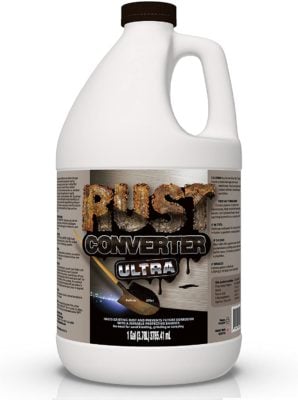

Editor’s Rating:
Active ingredient: Tannic acid
Appearance: White to brown liquid
The Rust Converter Ultra comes in a one-gallon bottle that will cover 500 square feet of smooth, nonporous surface. Unlike Rust Kutter, the formula is based on tannic acid, rather than phosphoric acid, which is just as effective while being much milder as a substance.
Type of converter
The main ingredient is tannic acid at around 6% by weight, which is a good amount to make the treatment effective. Tannic acid converts rust by reacting with iron oxides to form a stable, blue-black surface. The formula contains a proprietary polymer that acts as a primer for the treated surface, so you can further protect the object with minimal effort.
Preparation and use
The rust converter doesn’t require thinning and can be applied with a brush, roller, or pump sprayer. Shake well before using, and try to avoid applying the converter to non-rusted areas as they will turn white.
After 10 minutes from the application, the rust will start turning black, but the full conversion takes around 24 hours to finish, so patience is required.
Safety
As the formula is much milder than that of Rust Kutter, it is much safer to use. It is advisable to wear gloves, as tannic acid can irritate and will stain the skin.
The brush or roller should be cleaned with soap and water, and the product should be stored in a cool dry place to avoid degradation and prolong shelf life. Avoid temperatures below freezing and above 100o, and do not apply the product if the surface temperature is below 50o, as the treatment will be completely ineffective!
Pros
- Can be used with a pump sprayer
- Milder than phosphoric acid formulations while just as effective
- Can cover a large surface area
Cons
- Can be wasteful if you only require a small amount of converter
3. Corroseal Water-Based Rust Converter
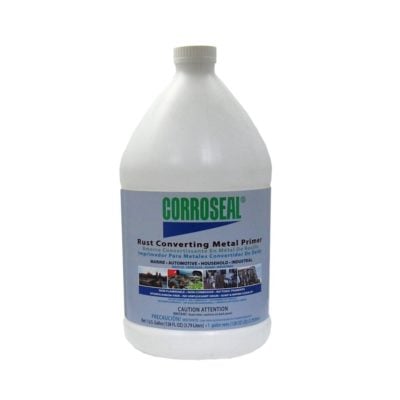

Editor’s Rating:
Active ingredient: Gallic acid
Appearance: Milky white/beige liquid, mild odor
The Corroseal rust converter is formulated with gallic acid, which is an alternative to the tannic acid used in formulations such as Rust Converter Ultra. It also contains a non-pigmented primer, so the surface you treat will be ready to paint in no time. If a large quantity is required, the Corroseal rust converter is available in 5-gallon bottles.
Type of converter
The main ingredient in this converter is gallic acid, which is a tannin derivative. It works by reacting with the rust and oxidizing it further to magnetite (Fe3O4), and iron gallate, which are stable complexes. This means that the newly formed surface is inert and will not rust while making sure the remainder of the rust below does not corrode any further. Although the primer itself isn’t pigmented, the treated rusty surface will turn black as magnetite is formed.
Preparation and use
Prepare the surface first by brushing off dirt and loose rust, and cleaning it with some rubbing alcohol. The formula can be applied using a brush, roller or spray, and will cover around 500 square feet per gallon if applied thinly. However, for best results each coat should be quite thick and you should allow it to dry for 15 minutes before recoating. After applying two coats let the surface dry and fully cure for 24 hours.
Safety
While this isn’t the most dangerous formulation on this list, it’s still important to wear at least a pair of nitrile gloves while working with this rust converter. It’s quite acidic at around pH 3 and is therefore irritating to the skin, eyes, and respiratory system. Just like Loctite Rust Neutralizer, it has the potential to cause harm to the reproductive system and an unborn baby, so it’s best to keep the exposure to a minimum.
The tools used for the application should be immediately cleaned up with some soap and water, as removing the converter once dry is very difficult.
Pros
- Non-flammable
- Great for marine uses as well as general household use
- Can be applied with a sprayer
Cons
- Can cause long term harm
- Need to lay it on thick for best effect
4. Loctite Extend Rust Neutralizer
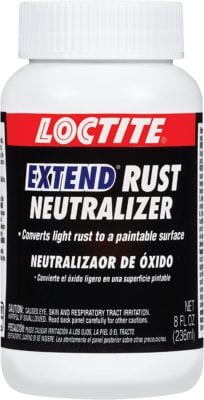

Editor’s Rating:
Active ingredient: None
Appearance: Mild odor, milky liquid
With this product, Loctite shows it can do more than glue formulations—and that it can do it well. The Extend range from the brand will equip you with everything you need to treat rusty surfaces. This rust converter is milder than both the Rust Kutter and Rust Converter Ultra, as it doesn’t contain any active ingredients, and is most suited for mild surface rust.
Type of converter
This rust neutralizer doesn’t contain any acids that would react with iron oxides to create a stable iron complex. Instead, this is a latex polymer formulation that will seal off the rust, preventing further corrosion, and will render a rusty surface paintable. Barium sulfate is used (along with tannins) to color the treated surface black.
Preparation and use
To treat the rusty surface, a minimum of two coats is required – a new coat should be applied after no more than 20 minutes. Overall, the cure time is 24 hours, during which the surface should be protected from water. Once dry, the surface can be painted using a product that is not zinc or copper-based.
Safety
The use of nitrile gloves is recommended to protect the skin during application and cleanup as the ingredients are irritating, harmful, and can cause skin sensitization. The tools should be cleaned with detergent and water immediately after use to avoid buildup which will be very difficult to remove. Although not as irritating or corrosive as formulations using acids, this product is classed as a potential carcinogen with the ability to cause reproductive harm. For these reasons, this product may not be available in California under Proposition 65.
Pros
- Convenient size
- A great alternative to phosphoric and tannic acid
- Made by a well established, trusted brand
Cons
- Not the best option for serious rust
- Potentially harmful to health
5. 3M Mar-Hyde 3513 One-Step Rust Converter


Editor’s Rating:
Active ingredient: Tannic acid
Appearance: Aromatic odor, white liquid
Perfect for use in the automotive industry and with any projects where you don’t want to fuss with multiple steps, the Mar-Hyde 3513 formulation contains tannic acid to convert the rust, as well as vinyl acrylic polymers for ease of application. Very similar to Rust Converter Ultra, it uses its secret polymer along with a special blend of ingredients to provide you with an effective, rust tackling formula.
Type of converter
The product relies on tannic acid to convert the rust into stable iron tannate. The tannic acid content is between 3 and 7% which is similar to Rust Converter Ultra’s formula with 6%, meaning it will do the job just as well but with a premium price tag. However, the concoction contains 9 ingredients, which is quite a few more compared to competitors. While you might argue that simpler is better, the secret recipe of this converter might be just what your rusty surfaces are crying out for.
Preparation and use
Follow the standard preparation procedure before applying the product. This converter is best applied with a brush that should be washed with soapy water after use. The formula is acidic at a pH of between 2 and 4, so do wear gloves during application and cleanup. Allow the surface to dry between coats for at least 30 minutes. Once the surface is cured after 24 hours, it is ready to paint.
Safety
The formula is methanol-based, which poses a toxicity risk as well as a potential carbon monoxide release if heated. To avoid toxic vapors and a possible explosion, keep the converter away from direct sunlight and heat sources. Due to the formula containing ingredients classed as harmful to aquatic life, try to prevent the product from getting into sewage or water sources. The substance has also been recorded to be a potential animal carcinogen due to one of the ingredients, so take the appropriate precautions to keep yourself safe (wear PPE!).
Pros
- Super effective formula
- Easy to use
- A good primer for paint
- Quick to dry compared to most other converters
Cons
- Not the most affordable
- Contains a potential animal carcinogen
6. Evapo-Rust The Original Super Safe Rust Remover
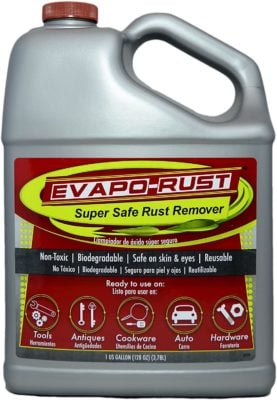

Editor’s Rating:
Active ingredient: None
Appearance: Light amber to yellow liquid, pleasant odor
While this is not your traditional rust converter, if you want something that is environmentally friendly and you’re dealing with mild surface rust, this is the best option. In the case of slight surface rust, the removal of corroded material will not be an issue and will not require harsh chemical treatment.
Type of converter
If you need to treat mild rust on surfaces where the application of a true rust converter is unsuitable, particularly due to toxicity, this is a super safe yet effective option. It has a proprietary water-based formulation with a pH of around 6 and is mostly composed of detergent and chelating agents. These chelating agents are substances that bond to the rust particles while the detergent works to dislodge them from the surface, leaving behind the rust-free metal underneath.
Preparation and use
As this product is reusable, it is best used for soaking rusty items in order to clean them. For the best results, make sure the surface is free from oil and grease before soaking it in Evapo-Rust. If the surface you’re trying to treat cannot be soaked in a traditional way, you can wrap a rag around the rusty surface that has been soaked prior with the rust remover. Leave the rag, making sure it stays saturated with Evapo-Rust for the necessary amount of time to clean the rust.
As this is simply a rust remover, it will not protect the cleaned surface. You should ensure that the rust doesn’t develop again by taking appropriate steps to protect the surface.
Safety
This is one of the safest rust treatment options out there. Even though it’s super safe, we would still not recommend drinking it—even if you’re feeling a little rusty.
Pros
- Non-toxic
- Biodegradable
- Reusable
Cons
- Doesn’t stop corrosion
- Only suitable for mild surface rust
7. Rust-Oleum Automotive Rust Reformer Spray
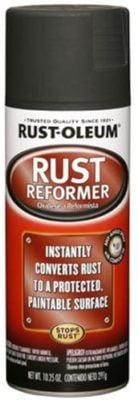

Editor’s Rating:
Active ingredient: None
Appearance: Opaque liquid, solvent odor
Rust-Oleum Rust Reformer is an inhibitor rather than a true converter. It claims to convert the rusty surface into a paintable one, however that does not make it a converter in a chemical sense. It’s still a great alternative to a converter, as it will do just as good of a job at protecting the surface from further corrosion.
Type of converter
When the label says that it “converts rust to a paintable surface,” what it means is that it’s a good primer. This product doesn’t convert rust as signified by the lack of active ingredients in the formula that would react with iron oxides. Instead, it’s a blend of chemicals that will bond to the rusty surface, protecting it from further corrosion.
Preparation and use
It’s recommended to clean up the rusty surface before applying the treatment. Although the instruction label suggests soap and water to clean the area to be treated, this can leave behind a residue that may impact the adhesion of the primer. The surest way to prepare the surface is to use rubbing alcohol to remove any grease and oil.
The container not only features a large spray tip for ultimate comfort while working but the product can also be sprayed at any angle, enabling you to work on hard to reach areas.
Safety
The formulation in this rust reformer is full of flammable and harmful substances such as methanol, as evidenced by the solvent odor. It is important to use this spray in a well-ventilated area as the vapors are toxic. Be sure to wear gloves while working with the product to minimize the risk of skin contact, as ethylbenzene used in the formula is a suspected carcinogen.
Pros
- Easy to apply
- Comfort finger pad
- Any angle spray nozzle
Cons
- Contains ethylbenzene
- Highly flammable
8. RUST BULLET Automotive
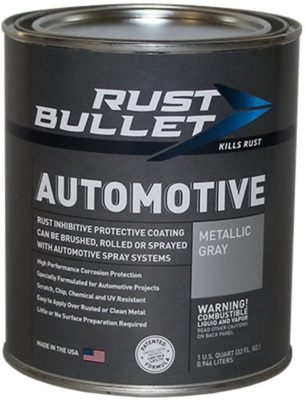

Editor’s Rating:
Active ingredient: None
Appearance: Silver liquid, hydrocarbon odor
Just like Rust-Oleum Automotive, this is a primer specifically formulated for the automotive industry. This product is a polyurethane coating, using a proprietary polymer that will adhere to the rust and bare metal alike, and provide you with a protected surface that resists corrosion.
Type of converter
The formulation of this primer contains aluminum, to not only provide the nice metallic finish but also to protect the surface from rust. It’s one of few rust treatments that will seal away rust and leave you with a grey metallic surface that doesn’t require any further paint or topcoat. It’s specifically created to treat the underside of vehicles as an all in one treatment, so you can get back on the road as quickly as possible. The full curing time is 72 hours, and the finish can handle continuous temperatures of up to 314oF.
Preparation and use
This primer is a great treatment for existing rust as well as a preventative treatment against corrosion. The product can be applied with a brush, roller, or HPLV spray equipment, such as REXBETI Ultimate-750 Paint Sprayer, and it doesn’t require mixing prior to application. Before application, the surface will need to be clean and free from grease and oil to ensure the best performance of the treatment.
Safety
The formula of Rust Bullet Automotive is hydrocarbon-based, meaning it is insoluble in water. Wear gloves during the entire process to protect your skin from the hazardous ingredients. The formula contains aromatic solvents which are known to be potentially carcinogenic, but keeping the area well ventilated as well as wearing gloves will significantly minimize the risk. To clean up the equipment, it is recommended to use a paint thinner or lacquer thinner. Due to the composition, the product is flammable and it is recommended to use it in a well-ventilated area.
Pros
- No mixing required
- Can be applied to non-rusted metal as well as rust
- UV resistant
- Not toxic to aquatic life
Cons
- Flammable
- Contains aromatic solvent
9. GEMPLER’S Eco-Friendly RCQ Rust Converter and Primer All-in-One


Editor’s Rating:
Active ingredient: Unknown
Appearance: Beige, opaque emulsion, bland odor.
Gempler’s Rust Converter uses a proprietary formula that just works. How it works is not clear, though, as the manufacturer doesn’t list all the ingredients, even on their safety data sheets. However, if you’re comfortable with the secrecy regarding the formula, and you want something that works, you won’t be disappointed by this product. One quart of this magic mix will cover up to 125 square feet of a smooth surface.
Type of converter
It’s difficult to say what type of a converter this product is due to the lack of information from the manufacturer. The treated rust surface will turn black, which suggests a tannin derivative is present, which would make sense given the low pH of around 2. The only ingredient listed is a surfactant, which strongly suggests that the formula does contain an active ingredient, and will indeed react with the rust to form a stable layer.
Preparation and use
The formula can be applied using a brush or a sponge to a clean rusty surface. For best results a total of four coats is recommended, and should be applied in a well-ventilated area. The treated surface is ready to paint with an oil-based paint in 48 hours.
Safety
It’s difficult to objectively judge safety when the exact ingredients are kept secret. The manufacturer does assure you however, that the product is water-based, non-flammable, and eco-friendly, which does agree with the safety data sheet. This will provide for easy cleanup as the application tools can be cleaned with a bit of soap and water. As with any rust converter on this list, it is classed as a health hazard, and due caution in the form of PPE should be observed.
Pros
- Water-based and eco-friendly
- Easy to clean up
- Non-flammable
Cons
- The company is not transparent about the formula
- More coats required than other products
Everything You Need to Know About Rust Converters
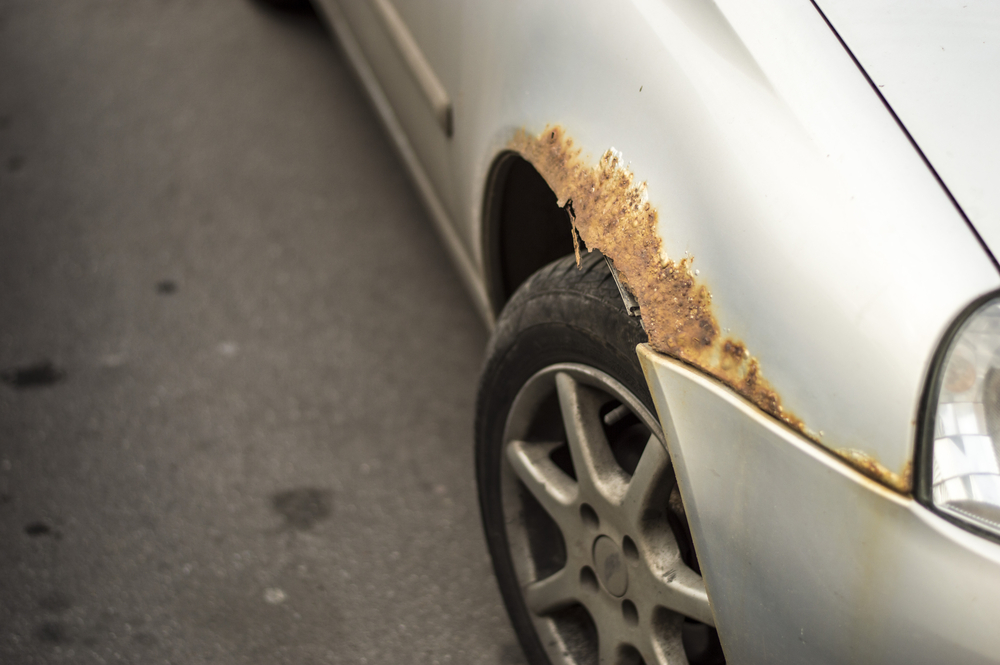
To get the most out of your rust converter, here’s a quick guide to the world of chemical rust treatments. From assessing your situation through to application, this guide will help you choose the right rust converter and get the best results no matter which product you pick.
Assessment of the situation
Knowing what you’re dealing with is an important step towards picking the right product to resolve the problem. Rust (Fe2O3) is a result of the oxidation of iron generally through contact with air and moisture, meaning that objects containing iron are susceptible to rusting if not preserved correctly.
What type of rust converter should I use?
For iron and steel items there’s a choice between converter, inhibitor, and remover. Using a remover will indeed remove rust, and with enough patience, it can remove all the rust to bare metal. However, this isn’t necessarily the ideal solution, particularly for deep rust as enough material can be removed to leave you with almost nothing. A more conservative treatment is to either convert the surface rust into an inert surface or to simply seal away the rust with an inhibitor. It’s important to remember that if you’re treating a structural object that is weight-bearing, using a rust converter will not improve the structural integrity.
Materials not containing iron, such as chrome can’t themselves rust, however, corrosion can form on the surface if they are in contact with another object containing iron. In such cases the best, and the only way is to remove the orange menace, otherwise you’d be left with the same ugly surface, just black instead of orange.
How to prepare the surface to be treated
Regardless of whether you pick a converter or an inhibitor, you will need to prepare the rusty surface for the product. The same procedure applies which is straightforward:
- Use a stiff bristle brush to remove loose rust and dirt from the surface. It’s important to provide a stable surface that won’t be flaking off.
- For an extra smooth surface use some steel wool to sand down irregularities.
- Use a degreaser, isopropyl alcohol, or methylated spirits to clean the surface from dust, grease, and oil. Allow the surface to dry.
- Apply the converter or inhibitor.
Follow the guidelines on the product packaging regarding the wait time before applying another coat. Allow the item the full cure time, which will vary depending on the product you’ve chosen, after which you can paint the surface if necessary.
Of course, you don’t need – and you shouldn’t – clean to bare metal, as this defeats the purpose of using a converter in the first place. The point is to remove flakes and loose rust, not only to reduce the surface area needing to be treated but also to prevent rust from forming as flaked off bits will most likely reveal a rusty patch underneath that will then corrode again.
Types of solutions
Now here’s a little bit of background rust chemistry to help you with understanding the problem you’re trying to solve, so you can pick the best solution for your situation.
1. Rust converters
A rust converter will react with the rust to provide a stable surface that prevents further corrosion for a relatively short period of time of around a couple of weeks. They’re usually formulated with a primer to allow for a coat of paint that will help to prevent rust in the long term.
While all rust converters will do their job on corrosion, the ingredients might be harmful to other materials. Some will turn good iron or steel a white color or even induce rust as iron is oxidized, so be careful where you apply it. Most converters are also highly acidic, with a pH below 4, so they will damage and corrode away things like plastics or rubber.
The three most common active ingredients in a converter are tannic acid, phosphoric acid, and gallic acid which are well researched.
Tannic acid
Tannic acid, used as the active ingredient in products like FDC Rust Converter Ultra will convert rust into a stable complex of iron tannate which turns the surface a blue-black color. This complex is tightly bound to the surface and is insoluble in water. It’s a common treatment of antiques due to the coloring as well as mild water resistance.
However, materials such as leather, paper, and fabrics can be stained and damaged if treated with tannic acid, so care should be taken to protect all non-ferrous surfaces.
Phosphoric acid
Phosphoric acid, similarly to tannic acid, will react with iron oxide to form iron phosphate which is inert and more structurally stable. This is a highly effective rust converter used in products like Rust Kutter, our top overall choice, that are typically for more serious rust problems due to the harshness of the treatment. The treated surface can turn either black or grey depending on the conditions.
Gallic acid
Just like tannic acid, gallic acid is a tannin derivative. It converts rust into a stable Fe3O4 complex, also called magnetite, as well as creating a layer of iron gallate. The converted surface turns black due to the presence of magnetite. Many great rust converters, including Corroseal Water-Based Rust Converter, use gallic acid.
2. Rust inhibitors
Inhibitors like the Rust-Oleum Automotive Rust Reformer Spray are a mix of polymers that provide a stable surface to paint on without disturbing the rusty surface. The rust remains beneath but because oxygen and water can’t get through the inhibitor, corrosion is stopped and the surface is protected.
These products contain organic solvents that are not acidic like the converters but pose their own hazards for example in the form of causing dizziness or being highly flammable.
Some of these products are marketed as converters despite not having any active ingredients. This refers to the product converting the surface to a stable, paintable one, rather than converting the rust through a chemical reaction.
3. Rust removers
A remover like Evapo-Rust will attack the rust and etch the surface to remove it. It’s a good option when sandblasting isn’t possible. This removes material, which is not ideal for very rusty objects and is best used on mild surface rust. They are the safest option as the removers don’t tend to use harsh acids or toxic hydrocarbons.
Frequently Asked Questions
How do I learn more about a rust converter?
To find out all the specifications of a chemical such as a rust converter, look for safety data sheets (SDS) of the product on the manufacturer website.
Do I need to sand a surface before treating it?
Not always, but it may be helpful if your surface is particularly damaged. If you want a smoother surface, use fine sandpaper (around 320 grit) to sand between coats of treatment. Don’t sand the final coat however as this will render the treatment ineffective.
How much rust converter do I need to use?
Using too much or too little can be an issue. If applied thick, the dry time may be much longer, and it’s a waste of product as putting the rust converter on a stable surface will not act as any more preventive action. Not using enough will leave you with speckles of corrosion still remaining. Always follow manufacturer guidelines for optimal results.
Can I paint over rust converter?
Don’t paint over rust converter until it has fully cured. Typically, this takes about 48 hours, but this may depend on the product, so read the package materials well before you move forward.
How long does rust converter last?
Most rust converters last about two years from when they’re purchased, regardless of whether or not they’ve been opened. Using expired rust converters can not only reduce their effectiveness but even damage the surface they’re applied to, so be sure to replace any out-of-date products.
Final thoughts
At the end of the day, the best rust converter is the one that works for you. Choosing an appropriate treatment and following safety guidelines will make the job of battling your rust faster, more efficient, and frustration-free.



